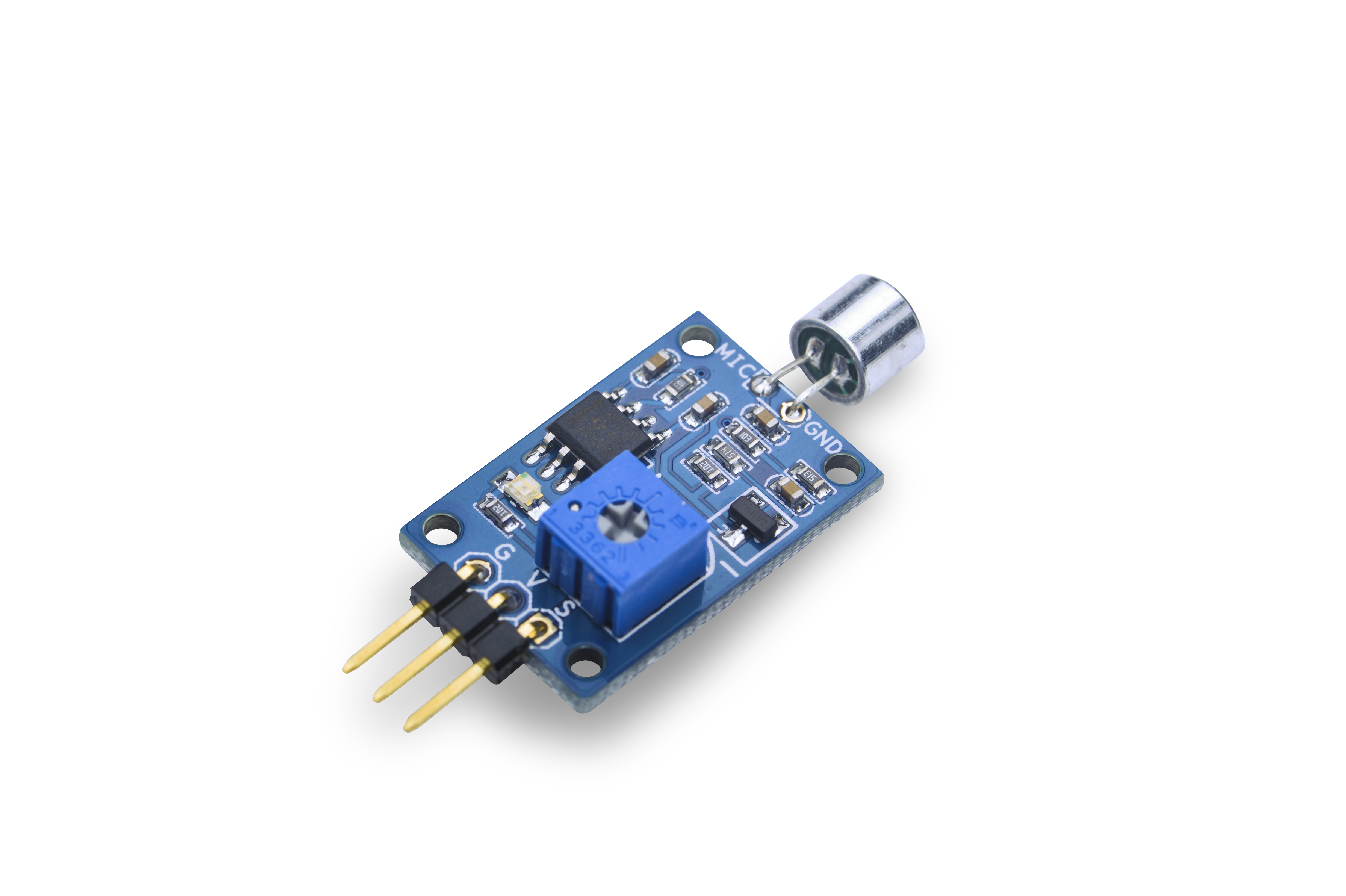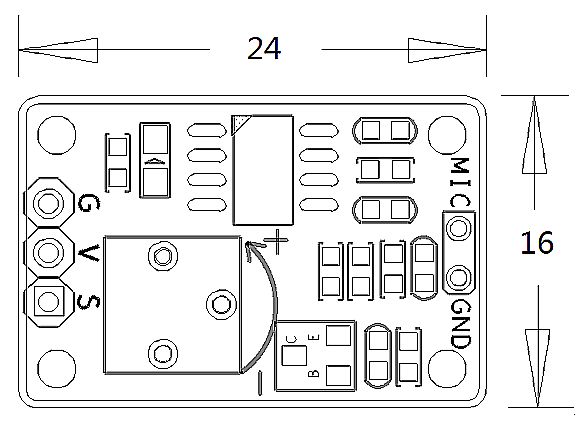Difference between revisions of "Matrix - Sound Sensor"
(→与NanoPi 2连接使用) |
(→运行测试程序) |
||
| Line 83: | Line 83: | ||
The modules are under the "modules" directory. The driver's source code is in github: https://github.com/friendlyarm/linux-3.4.y.git <br> | The modules are under the "modules" directory. The driver's source code is in github: https://github.com/friendlyarm/linux-3.4.y.git <br> | ||
| − | === | + | ===Run Test Program=== |
| − | + | Please insert a TF card which is flashed with Debian to a Linux host and mount its boot and rootfs sections.<br> | |
| − | + | We assume the rootfs is mounted to /media/rootfs then please run the following commands to copy the module, library and test program to the card.<br> | |
<syntaxhighlight lang="bash"> | <syntaxhighlight lang="bash"> | ||
$ cp modules /media/rootfs/ -r | $ cp modules /media/rootfs/ -r | ||
| Line 92: | Line 92: | ||
</syntaxhighlight> | </syntaxhighlight> | ||
| − | + | Insert this TF card to your NanoPi 2, power on and run the following commands to load the driver.<br> | |
<syntaxhighlight lang="bash"> | <syntaxhighlight lang="bash"> | ||
$ cd /modules | $ cd /modules | ||
| Line 98: | Line 98: | ||
</syntaxhighlight> | </syntaxhighlight> | ||
| − | + | Start the matrix-sound_sensor program.<br> | |
<syntaxhighlight lang="bash"> | <syntaxhighlight lang="bash"> | ||
$ matrix-sound_sensor | $ matrix-sound_sensor | ||
</syntaxhighlight> | </syntaxhighlight> | ||
| − | + | Here is what you expect to observe:<br> | |
[[File:matrix-sound_sensor_result.png|frameless|600px|matrix-sound_sensor_result]] <br> | [[File:matrix-sound_sensor_result.png|frameless|600px|matrix-sound_sensor_result]] <br> | ||
| − | + | When you talk to the module your speech will be detected. When you adjust the resistor the module's sensitivity will be changed | |
===代码展示=== | ===代码展示=== | ||
Revision as of 09:54, 23 February 2016
Contents
1 Introduction
- The Matrix-Sound_Sensor module is used to detect sound.
- The module has a variable resistor which can be used to control the threshold value of a sound level. Only when a sound level's value is greater than this threshold the module can detect it. Turning clockwise increases this threshold value. Turning anticlockwise decreases this value.
- By default this module's output level is high. When it detects sound signals its output level will turn low. When sound signals are not detected its output will turn high again without time delay.
2 Features
- Variable threshold value
- 2.54mm spacing pin interface
- PCB dimension (mm): 16 x 24
- Pin Description:
| Pin | Description |
| S | GPIO |
| V | Supply Voltage 5V |
| G | Ground |
3 Basic Device Operation
- The module contains an electret condenser microphone. Sound waves impinging on the diaphragm cause the capacitance between it and the back plate to change synchronously, this in turn induces an AC voltage on the back plate.
- This sound sensor functions like a microphone which receives sound waves and convert them to images which show the sound waves' vibration. When it receives a sound wave it will output 1 but cannot measure its strength.
4 Download Matrix Source Code
All the matrix modules' code samples are open source. They are maintained on GitHub - https://github.com/friendlyarm/matrix.git
Each branch in this hub contains the matrix modules' code samples for a board that the matrix modules can work with.
- The nanopi branch contains the matrix modules' code samples for the NanoPi
- The nanopi 2 branch contains the matrix modules' code samples for the NanoPi 2
- The tiny4412 branch contains the matrix modules' code samples for the Tiny4412
- The raspberrypi branch contains the matrix modules' code samples for the RaspberryPi
Please follow the steps below to get the source code:
Install the git utility on a PC running Ubuntu14.04
$ sudo apt-get install git
Clone the matrix code from GitHub
$ git clone https://github.com/friendlyarm/matrix.git
If this is successful a "matrix" directory will be generated, which will contain all the matrix modules' code samples.
5 Connect to NanoPi 2
5.1 Hardware Connection
Please refer to the following connection diagram to connect the Matrix-Sound_Sensor to the NanoPi 2:
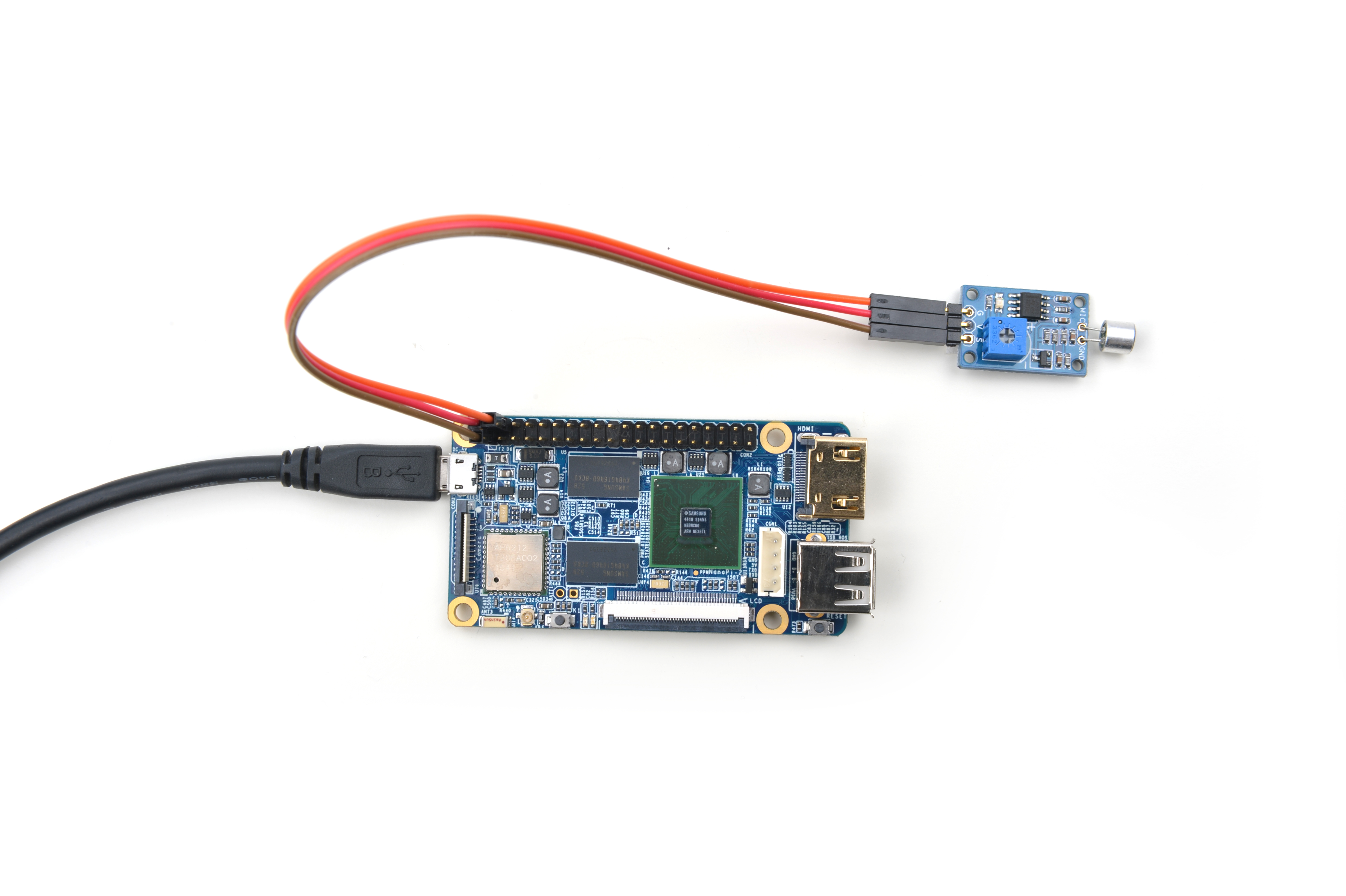
Connection Details:
| Matrix-Sound_Sensor | NanoPi 2 |
| S | Pin7 |
| V | Pin4 |
| G | Pin6 |
5.2 Compile Test Program
Please login the matrix hub and enter the nanopi2 branch
$ cd matrix $ git checkout nanopi2
Compile the matrix code
$ make CROSS_COMPILE=arm-linux- clean $ make CROSS_COMPILE=arm-linux- $ make CROSS_COMPILE=arm-linux- install
Note: please make sure to install the cross compiler "arm-linux-gcc-4.9.3" on your PC, which is used to compile files for the NanoPi 2.
Generated library files are under the "install/lib" directory. The test program is under the "install/usr/bin" directory.
The modules are under the "modules" directory. The driver's source code is in github: https://github.com/friendlyarm/linux-3.4.y.git
5.3 Run Test Program
Please insert a TF card which is flashed with Debian to a Linux host and mount its boot and rootfs sections.
We assume the rootfs is mounted to /media/rootfs then please run the following commands to copy the module, library and test program to the card.
$ cp modules /media/rootfs/ -r $ cp install/lib/* /media/rootfs/lib/ -d $ cp install/usr/bin/* /media/rootfs/usr/bin/
Insert this TF card to your NanoPi 2, power on and run the following commands to load the driver.
$ cd /modules $ insmod matrix_gpio_int.ko
Start the matrix-sound_sensor program.
$ matrix-sound_sensorHere is what you expect to observe:

When you talk to the module your speech will be detected. When you adjust the resistor the module's sensitivity will be changed
5.4 代码展示
static struct sensor sound[] = { { GPIO_PIN(7), IRQ_TYPE_EDGE_BOTH, } }; int main(int argc, char ** argv) { int i; int retSize = -1; char value[ARRAY_SIZE(sound)]; int devFD = -1; if (argc == 2) { sound[0].pin = atoi(argv[1]); } printf("Using GPIO_PIN(%d)\n", sound[0].pin); if ((devFD =sensorInit(sound, ARRAY_SIZE(sound))) == -1) { printf("Fail to init sensor\n"); return -1; } printf("Please speak...\n"); if ((retSize = sensorRead(devFD, value, ARRAY_SIZE(sound))) == -1) { printf("Fail to read sensors\n"); } if (retSize > 0) { i = 0; for(i=0; i<retSize; i++) { printf("sound[%d]:%d\n", i, value[i]); } } sensorDeinit(devFD); return 0; }
6 Connect to NanoPi
6.1 Preparations
Please install a Debian on a NanoPi and an appropriate cross compiler on a PC. Please refer to wiki :NanoPi
Compile a NanoPi kernel. Note: please use the kernel's source code from the nanopi-v4.1.y-matrix branch.
$ git clone https://github.com/friendlyarm/linux-4.x.y.git $ cd linux-4.x.y $ git checkout nanopi-v4.1.y-matrix $ make nanopi_defconfig $ touch .scmversion $ make
6.2 Hardware Connection
Please refer to the following connection diagram to connect the Matrix-Sound_Sensor to the NanoPi
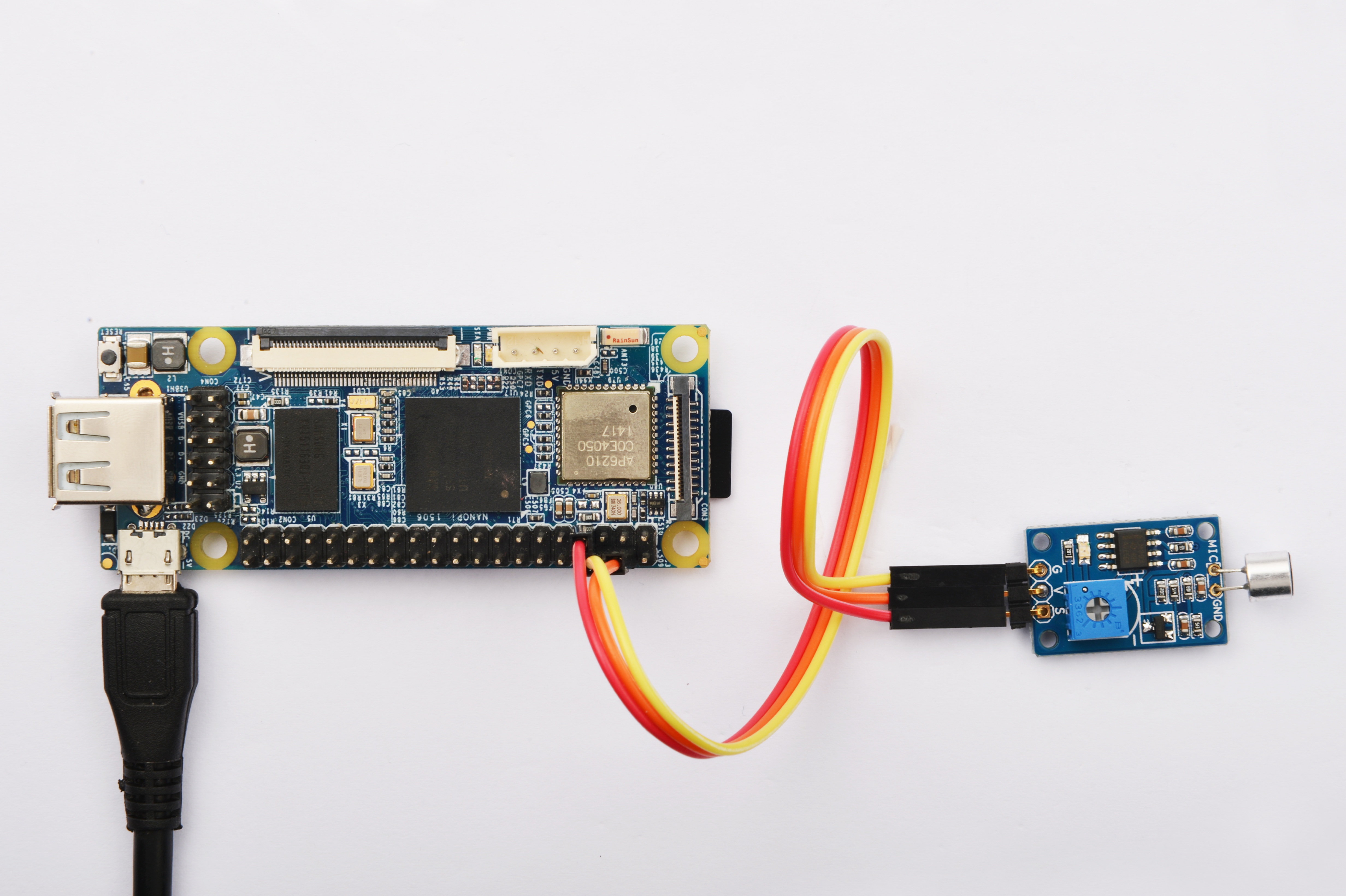
Connection Details:
| Matrix-Sound_Sensor | NanoPi |
| S | Pin7 |
| V | Pin4 |
| G | Pin6 |
6.3 Compile Test Program
Please login the matrix hub and enter the nanopi branch
$ cd matrix $ git checkout nanopi
Compile the matrix code
$ make CROSS_COMPILE=arm-linux- clean $ make CROSS_COMPILE=arm-linux- $ make CROSS_COMPILE=arm-linux- install
Note: please make sure to install the cross compiler "arm-linux-gcc-4.4.3" on your PC, which is used to compile files for the NanoPi-Debian.
Generated library files are under the "install/lib" directory. Applications are under the "install/usr/bin" directory. The test program for the "Matrix-Sound_Sensor" module is "matrix-sound_sensor".
6.4 Run Test Program
Please copy the library files and test program to the NanoPi
$ cp install/usr/bin/* nanopi_rootfs/usr/bin/ $ cp install/lib/* nanopi_rootfs/lib/ -d
Power on the NanoPi and run the following command in Debian's terminal
$ matrix-sound_sensor6.5 Code Sample
static struct sensor sound[] = { { GPIO_PIN1, IRQ_TYPE_EDGE_BOTH, } }; int main(void) { int i; int retSize = -1; char value[ARRAY_SIZE(sound)]; int devFD = -1; if ((devFD =sensorInit(sound, ARRAY_SIZE(sound))) == -1) { printf("Fail to init sensor\n"); return -1; } if (( retSize = sensorRead(devFD, value, ARRAY_SIZE(sound)) ) == -1) { printf("Fail to read sensors\n"); } if (retSize > 0) { i = 0; for(i=0; i<retSize; i++) { printf("sound[%d]:%d\n", i, value[i]); } printf("\n"); } sensorDeinit(devFD); return 0; }
7 Connect to Tiny4412
7.1 Preparations
Please refer to the Tiny4412's user's manual to install a UbuntuCore on the Tiny4412 and install an appropriate cross compiler on a PC.
Note: only the Tiny4412SDK-1506 carrier board can work with this module.
7.2 Hardware Connection
Please refer to the following diagram to connect the Matrix-Sound_Sensor to the Tiny4412
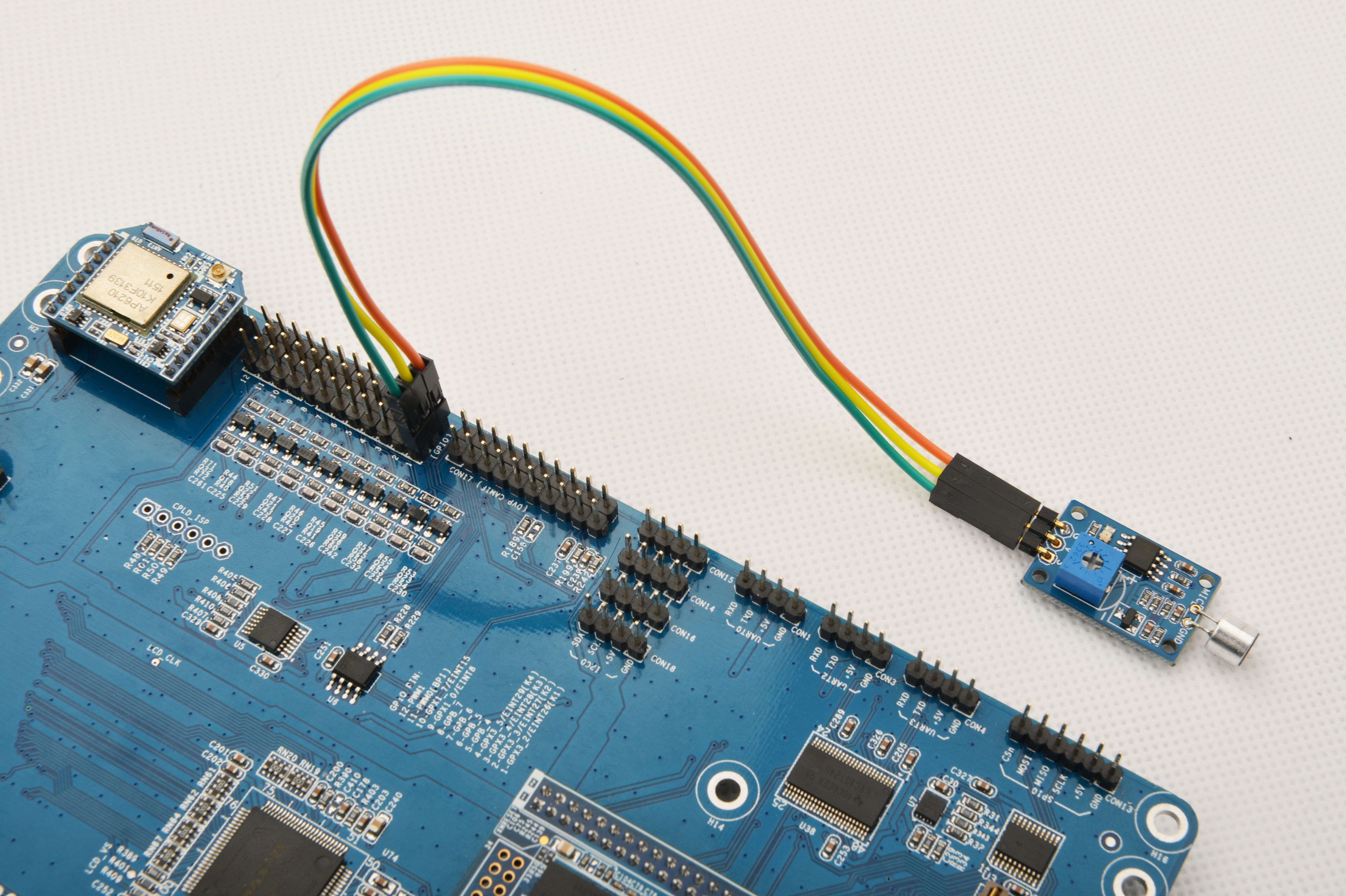
Connection Details:
| Matrix-Sound_Sensor | Tiny4412 |
| S | GPIO1 S |
| V | GPIO1 5V |
| G | GPIO1 GND |
7.3 Compile Test Program
Please login the Matrix hub and enter the matrix-tiny4412 branch
$ cd matrix $ git checkout tiny4412
Compile the matrix code
$ make CROSS_COMPILE=arm-linux-gnueabihf- clean $ make CROSS_COMPILE=arm-linux-gnueabihf- $ make CROSS_COMPILE=arm-linux-gnueabihf- install
Note: please make sure to install the cross compiler "arm-linux-gnueabihf-gcc-4.7.3" on your PC, which is used to compile files for the Tiny4412-UbuntuCore.
Generated library files are under the "install/lib" directory. Applications are under the "install/usr/bin" directory. The test program for the "Matrix-Sound_Sensor" module is "matrix-sound_sensor".
7.4 Run Test Program
Please copy the library files and test program to the Tiny4412
$ cp install/usr/bin/* tiny4412_rootfs/usr/bin/ $ cp install/lib/* tiny4412_rootfs/lib/ -d
Power on the Tiny4412 and run the following command in UbuntuCore's terminal
$ matrix-sound_sensor7.5 Code Sample
static struct sensor sound[] = { { GPIO_PIN1, IRQ_TYPE_EDGE_BOTH, } }; int main(void) { int i; int retSize = -1; char value[ARRAY_SIZE(sound)]; int devFD = -1; if ((devFD =sensorInit(sound, ARRAY_SIZE(sound))) == -1) { printf("Fail to init sensor\n"); return -1; } if (( retSize = sensorRead(devFD, value, ARRAY_SIZE(sound)) ) == -1) { printf("Fail to read sensors\n"); } if (retSize > 0) { i = 0; for(i=0; i<retSize; i++) { printf("sound[%d]:%d\n", i, value[i]); } printf("\n"); } sensorDeinit(devFD); return 0; }
8 Connect to RaspberryPi
9 Connect to Arduino
10 Resources
11 Update Log
11.1 Feb-23-2016
- Added the description for "NanoPi 2 branch" in Section 4
- Added Section 5: Connect to NanoPi 2
